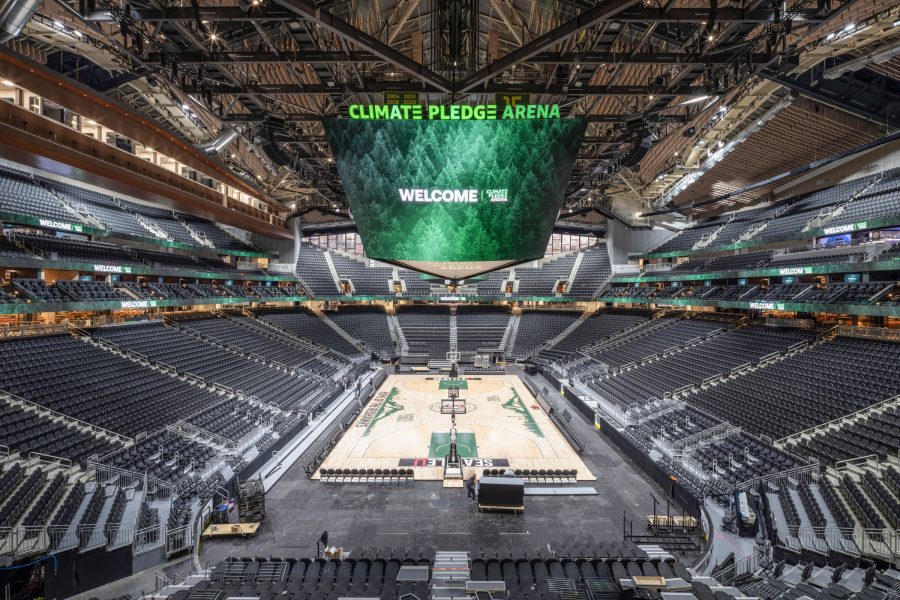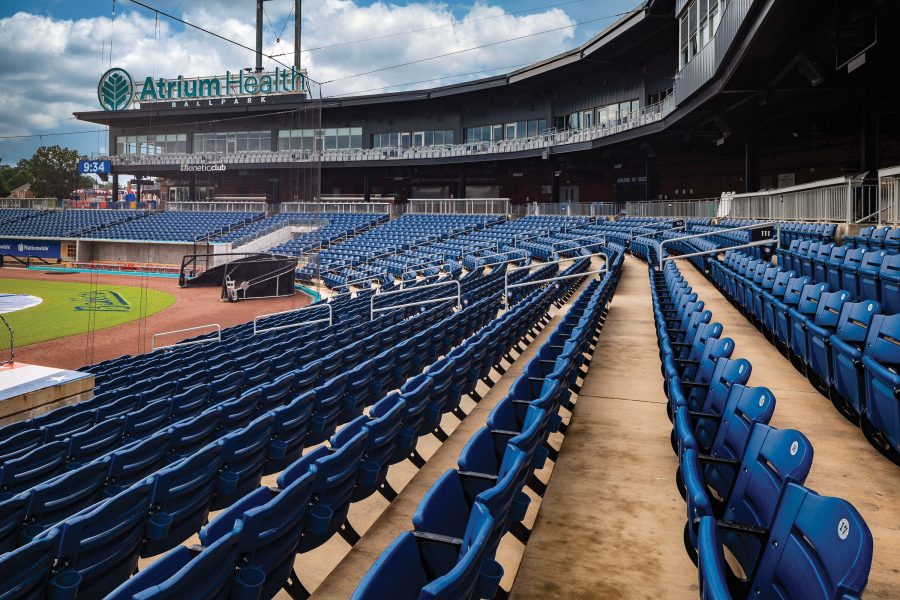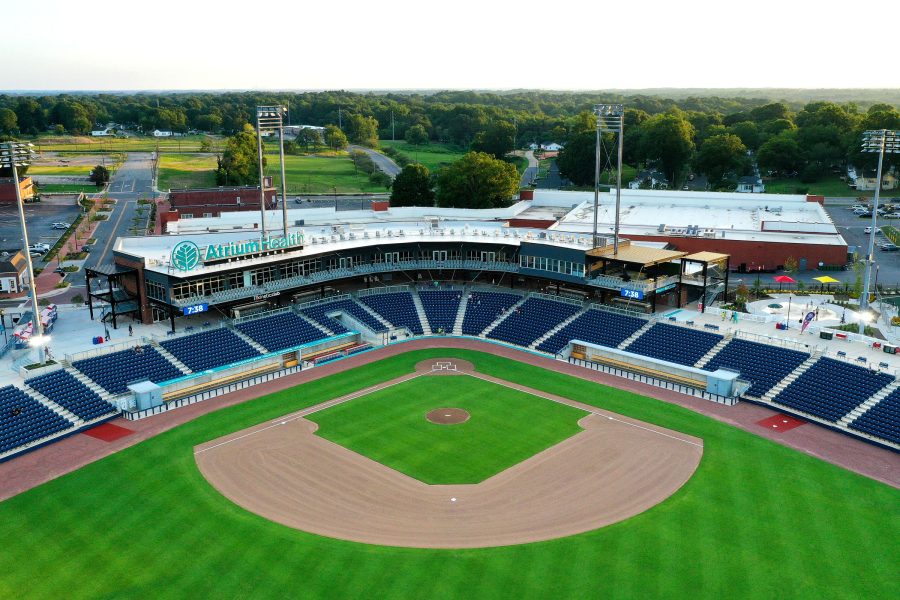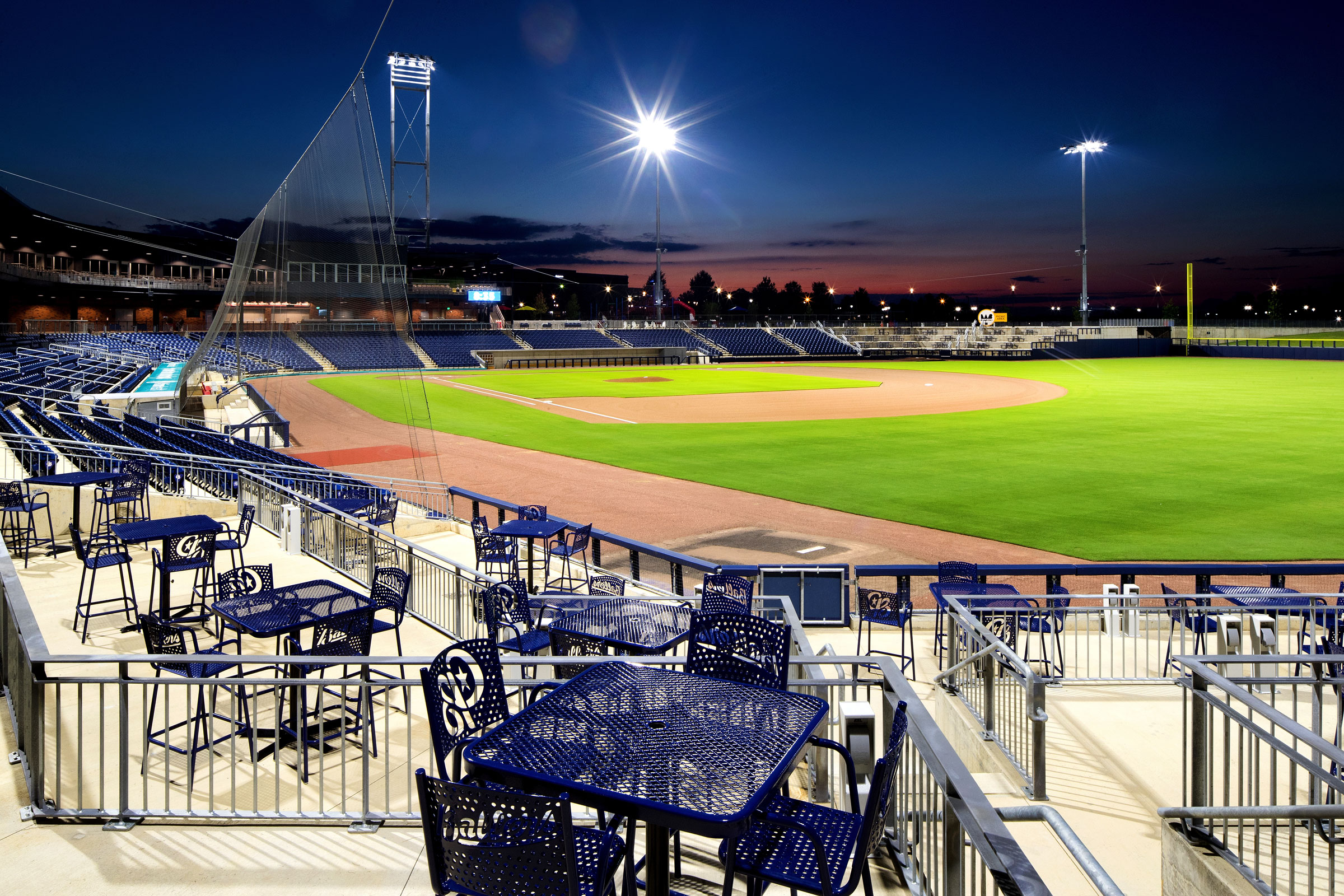Story at a glance:
- Design at stadiums and arenas all over North America is being dictated in large part by a demand for a variety of viewing and other experiences.
- The Populous-designed Atrium Health Ballpark opened in 2020 and includes Hussey Seating, with a capacity around 5,000 seats.
- Atrium Health Ballpark is an example of design for experiences—as it was developed as part of a massive downtown redevelopment project.
Forget popcorn and peanuts and Cracker Jacks; spectators today require a whole lot more of their outings. Today’s spectator experiences—from sports to concerts—are more social than ever, with plentiful other activities to choose from while you’re onsite as well as the ever-growing option to upgrade, upgrade, upgrade.
“Traditionally on the lower level you had the general admission seating, then the club suite, and then upper level general admission. That was the standard for most outdoor stadiums,” says Sean O’Leary, vice president of sales and marketing for Hussey Seating, a top manufacturer of seating across sports and entertainment venues. “Similarly with indoor arenas you had three seating differentiations—general admission, club, and suite. Now we’re seeing numerous seating areas, seating zones, different chair styles, different price points, and a really differentiated experience for fans.”
College games are feeling more like pro games, and the opportunities for shopping, dining, and socializing in areas around pro stadiums are expanding, too. “Almost all these new venues are adding an entertainment district around it to generate more revenue on off-game days,” O’Leary says.
Designing Excitement

Design at many arenas and venues today centers around offering a variety of viewing options. Photo by Alex Fradkin
Architect Jason Michael Ford has worked with Populous since 1996, helping to shape experiences everywhere from Phillies games to countless minor league parks and more. “Thirty years ago everyone was talking about capacity—the number of seats and the number of suites. That was the focus of a lot of projects early on. If you look back at buildings from the ’90s and 2000s, people thought the number of seats in general transcended to revenue.”
Today’s designs are focused more on providing a variety of social experiences, Ford says, adding that some are so special people will pay more for them. “We’re seeing a lot more social areas—so less fixed seating and more flexible seating—and open standing room areas where people can be with their friends. People want their experience in a venue to be different when they’re with their family, when they’re with their friends, when they’re with their coworkers. These facilities have to have price points and seating areas that cater to those different experiences. Take a Major League Baseball game, for example. If you’re going to 40 of the 81 home games, you don’t want to have 40 of the same experiences; you want to have different experiences.”
These facilities have to have price points and seating areas that cater to those different experiences.
Populous’ Geoff Cheong has been focused largely on the arena market for the last decade, with projects like T-Mobile Arena in Las Vegas and Climate Pledge Arena in Seattle. “There is a focus around creating these incredible experiences within our venues,” Cheong says. “One of the trends we’re seeing a lot in arenas is so much focus on experiences throughout the building other than the game or the concert or the main event you’ve paid for. People want to be able to explore the venue and experience these different activation zones and sponsor zones.” When designed well, these additional, tangible moments stick with patrons long after they leave, too. “It’s really driving additional revenue for our clients and operators as well.”
Cheong says Populous has put a lot of attention on evolving the actual in-seat experience in its arena designs, too. “We spend a lot of time creating a variety of seating experiences because, again, like Jason described, a lot of folks are looking to come to a venue time and time again and not wanting to do the same thing. They want to feel like they’ve had a different experience. They want to see the game or the action from a different vantage point, and they honestly want to even sit in a different type of chair. A standard folding arena chair is just one of the many different types of ways you can consume the event. We’re doing everything from individual, comfortable lounge chairs with arm tables or side tables to banquette seatings or even sofas or couches that are very unique ways to witness an event.”
Flexible Seating

The design for Climate Pledge Arena included Camatic seating in part for its sleek and flexible design. Photo by Alex Fradkin
Modern arenas and stadiums are being designed to be so much more than a place to watch a concert or game. Many are designed to be able to host various types of events. That’s where options like telescopic seating comes in, as it allows for maximum flexibility of floor plans.
“We go in and custom design the telescopic platforms to fit the allowable space, and we spend a ton of time upfront with the architect, designer, and the operators when available to really understand their needs,” O’Leary says. “Then we design the product to be able to not only accommodate those events but everything else they throw in, from rodeo to concerts to mixed martial arts, you name it. We really try to do more listening upfront around how the facility is going to look given every different scenario. With the telescopic retractable seating they can really change the seating capacity and the setup based on the events.”
Cheong says the industry has been challenged for many decades by how to maximize utilization in large-scale sports and entertainment venues. “The ultimate goal we constantly strive to design around is how do you as a client, as an operator, have more event days than non-event days? And how do you achieve that degree of flexibility and adaptability for a wide array of events?”
In addition to retractable telescopic platforms Hussey offers a broad range of fixed-seating options—from basic to super high-end. Designers have a seemingly infinite array of chairs to choose from in the categories of fixed, beam, and telescopic depending on what style, fabric, seatback, and even color is desired. The company recently acquired Camatic Seating, too, further adding to their portfolio of options for a one-stop shop with beam-mounted seating as well.
An increasing number of designers are also looking to specify more comfortable, upholstered seating on retractable platforms—something you couldn’t do 10 years ago but can today. Climate Pledge Arena included Camatic seating and was a highly competitive bid, O’Leary says. “The design team of Populous, Oakview Group, and Icon really put all of the players under the microscope,” he says, adding that the chosen Camatic chair was part of the arena’s overall sleek design. “It was the same chair that was on the retractable telescopic platforms as in the fixed seating bowl behind, and then different chairs used for suites in their upgraded areas. It’s a really good look, and it was a lengthy selection process and a great win for Camatic.”
Design for Efficiency

The Populous-designed Atrium Health Ballpark opened in 2020. Photo by Patrick Schneider
The main difference between installing a fixed stadium chair versus a beam mount stadium chair is that on a Hussey fixed stadium chair, where there is an armrest between each chair it’s also attached below to the concrete, O’Leary says. “If the chair was a 20-inch wide chair, you’d have two anchor bolts every 20 inches. With beam you only have to anchor it on average every 40 to 48 inches, depending on the layout of the facility. You’ve got half the anchor bolts, so your installation time is much less.”
The flexibility of beam mounted chairs leads to a longer life, too. For example, O’Leary says the Seattle Seahawks Camatic installation is more than 20 years old and going strong. Beam mounted also means an older stadium, say like the Chicago Bears’ stadium, could upgrade its seats or add drink tables without having to touch the beam, he says. “The beam is probably 40% of the installation cost.”
Hussey takes care of its customers long after installation, too, with a full service and parts department. They’ll continue to help with maintenance if needed and even help solve problems with a competitor’s products. That said, O’Leary says you get what you pay for. “It can be very competitive out there, and if a GC wants the lowest price that doesn’t necessarily serve the operator well for the next 8 or even 20-year lifespan, then that early savings didn’t turn out to be a savings.”
Atrium Health Ballpark

Atrium Ballpark in North Carolina is a Minor League park that includes Hussey Seating with a capacity around 5,000 seats. Photo courtesy of Hussey Seating
The Populous-designed Atrium Health Ballpark opened in 2020, 35 minutes outside of Charlotte, North Carolina, and includes Hussey Seating with a capacity around 5,000 seats. The Minor League ballpark is a great example of the trends happening today, O’Leary says, with a family seating area, box seating, elevated sky lounge, and even suite banquet space that can be rented on non-game days.
Outside of the seating area are even more designed experiences, like kids zones with a splash pad and walking trails around the stadium. “It’s all about getting people there not just to watch a ball game, but when you come to watch a ball game, you’ve also got multiple choices of how to do that.”
The site placement of that park is another win, Ford says, as the ballpark acts as an anchor bringing people downtown. Atrium is highly accessible to the public. “What’s probably most unique about this ballpark is it truly is a park,” he says. The concourse is open every day, and people walk it on non-game days, too. “We’re really proud of that ballpark.”
Atrium was named 2022 Ballpark of the Year by Ballpark Digest, in part for its beautiful grass berms, home run porch, and other amenities open to the community year-round. Its right field acts as an extension of the main street development, and the park is open from dawn to dusk daily for use as a public amenity.
An Accessible Future

Populous-designed Atrium Health Ballpark, home to the Kannapolis Cannon Ballers Minor League Baseball team, was honored as Ballpark Digest’s 2022 Ballpark of the Year. Photo by Patrick Schneider
Designing for spectators must not just be inviting and exciting, though; it must truly be accessible, and the idea of inclusive design is evolving, Cheong says. “If you are a person with a disability, how do we make a really positive experience for you within not only the venue but the seating bowl and where you’re watching that from. If you’re with young children, same thing. In the arena it’s a very important focus of ours right now, especially with renovations. We’re spending a lot of time in the world of renovations for buildings that were built before the early ’90s, when ADA code came into play. A lot of expertise and focus is required to make older venues really comfortable, accessible, and meaningful for that user group.”
He says accessible, inclusive design is what sustainability was like 20 years ago. “It’s going to be the next wave of focus and conversation in the sports and live entertainment industry,” Cheong says. “The saying is that there are two types of people in this world—people with disabilities and those of us who haven’t discovered ours yet.”

